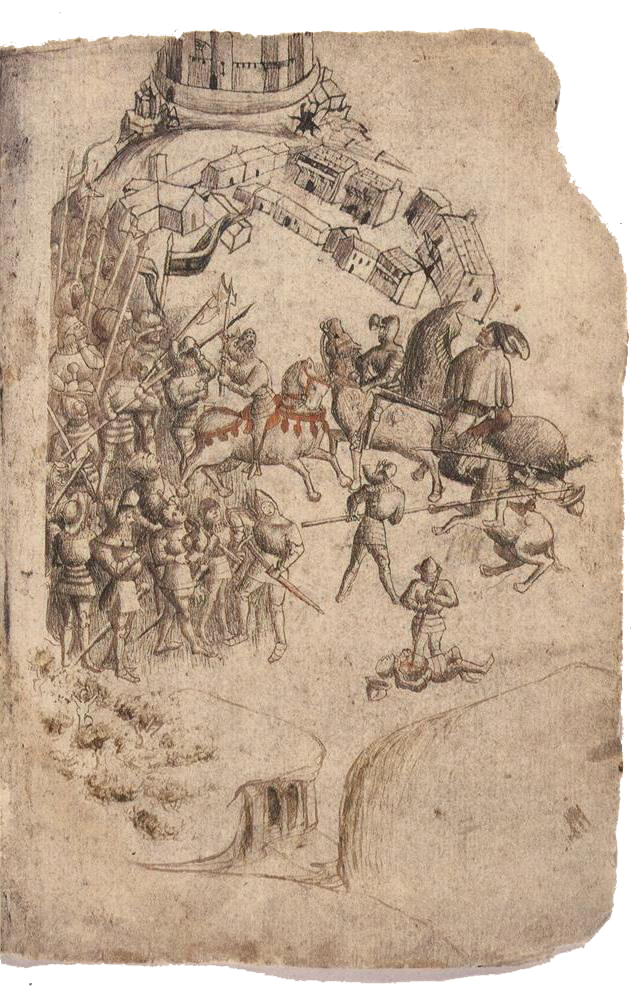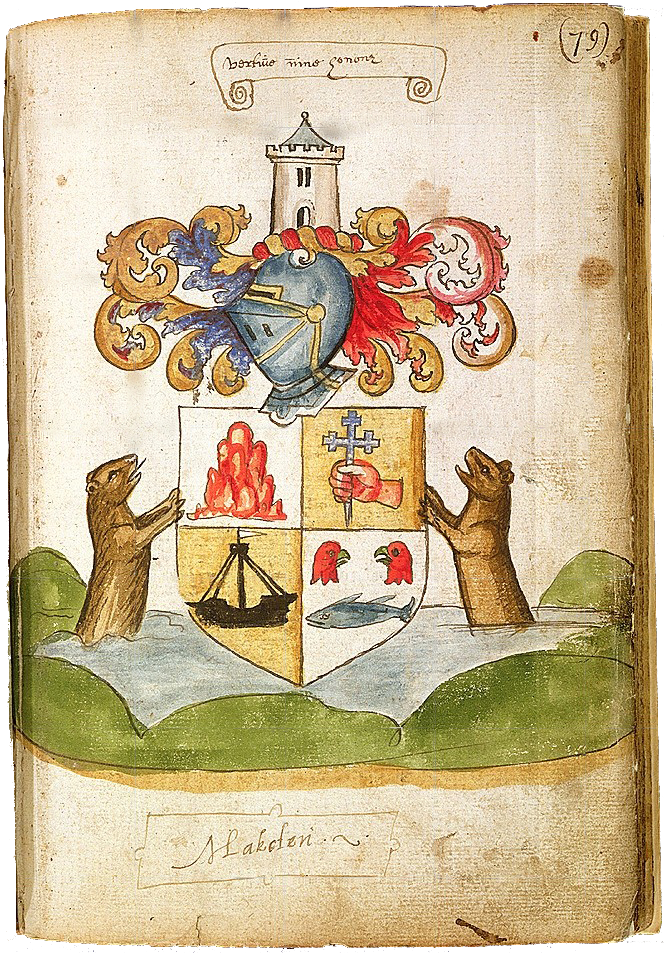13th Century — 14th Century
Although best remembered as warriors today, the earliest Macleans would likely have been recognized as one of the hereditary learned families of the Gàidhealtachd.6 Old Dugald’s position and designation as “judex,” along with his frequent change of dwelling coupled with the fact that his great grandson, Cuduiligh,6 born c.1130,14 was a learned Abbot of Lismore would have been common in the context of the Gàidhealtachd.6
As the Gaels and the Picts came together to define themselves as a single nation of Scots8 the early ruling houses of Scotland were essentially a dynastic continuation of Dálriadic line of kings.8 Before the Wars of Scottish Independence began the Macleans made powerful alliances both through well-timed strategic marriages6 and educating the children of allied leaders.1 Sea power would also come to figure heavily into the Macleans’ fortunes.

(NLS Adv.MS. 35.1.7)
The marriage of Malcolm mac Giliosa, third chief, to Rignach,6 daughter of Gamail, Mormaer (or Earl) of Carrick (a relation of the Bruces17) established Malcolm in both society and land,6 and in doing both many consider this the most important alliance in the early history of the Macleans. This marriage could not have come at a better time than the beginning of the transition of Scotland’s crown from the House of Balliol to the House of Bruce.1 The Carricks enjoyed great influence with the Scottish crown under the Balliol; however despite readily swearing allegiance to the Bruce they would never again have any meaningful influence with the crown.
Malcolm’s sons used their new influence established control and command of ships and shipping in the region.6 The rise of the House of Bruce put Scotland on a path to the Wars of Scottish Independence; a path that would rely heavily on sea-power which the Macleans were ready and eager to provide.
While being an influential family in the Gàidhealtachd may have helped establish Malcolm’s favor with the Earls of Carrick, it was the sea power commanded by his sons that the Bruce needed and helped accelerate their rise to prominence. Having the favor of both the outgoing and incoming ruling houses enabled the Macleans to thrive in the transition.
Oral tradition of the Clan Maclean insists that Malcolm fought with the Bruce at the Battle of Bannockburn on June 24th, 1314.1 Although not historically documented, this assertion is both logical and reasonable due to the facts that the Carricks were known to have fought with Bruce that day and the stood with the Bruce afterward.13 Strong ties to both the Carricks and Bruces would have made it difficult for the Macleans to avoid being drawn into the conflict.6
John Dubh, 4th Chief, sent his two eldest sons, Hector Reaganach and Lachlan Lùbanach, as ambassadors to discuss obtaining land on the Isle of Mull with John Macdonald of Islay, 1st Lord of the Isles. Though the brothers failed to persuade him, Macdonald asked the master of his household, MacFinnon, to make arrangements for them to eat alone as he and his men were preparing to depart for the Isle of Aros to observe the Festival of Pasch. As it was lent, MacFinnon provided the brothers no meat and food so brittle it was difficult to eat; checking in before his departure, Macdonald instructed MacFinnon to rectify the situation and departed alone in a small boat across the Sound of Mull for Aros. Rather than fulfilling his master’s instruction, MacFinnon insulted the brothers and set off with Macdonald’s men in the galley to join him at Aros. The brothers caught MacFinnon at the beach and took their revenge, killing him and stealing Macdonald’s galley. The brothers overtook Macdonald and leapt from the galley to his small boat, taking him prisoner, while the galley continued to Aros, but the brothers took Macdonald to Dunstafnage in Lorn. When the galley arrived at Aros, the men told Macdougall, one of Macdonald’s chieftains, of the situation. Macdougall said though Gillian’s children were bold in their attempt, he was glad Macdonald would have the opportunity to “bridle their forwardness and insolence.” Macdougall’s son, who was fostered by Gillian, reached the brothers and told them what his father said. Perplexed by the casual response, the brothers convinced Macdonald that they were not a force strong enough to challenge the Lordship of the Isles, and were only able to apprehend him by accident. Macdonald, being a shrewd man and wise, saw that in forgiving the brothers he would hold their loyalty and could leverage their boldness to his advantage. And so he did—Macdonald forgave and rewarded the brothers, giving Hector four score merks of land and Lachlan the chamberlainship of his house.17
The first official mention of a Maclean is in a papal dispensation issued by Pope Urban V on May 3rd of 136716 permitting the marriage of Lachlan Lùbanach Maclean, fifth Chief, to Mary Macdonald,15 daughter of the Lord of the Isles and granddaughter of Robert II, King of Scots. It appears the families were sufficiently intertwined that the approval of the Pope was necessary for the marriage to proceed. This marriage included a dowry of Duart Castle, whose custody and constableship was granted to Lachlan Maclean in 1390 in the earliest known charter from the Lords of the Isles.1 King James IV confirmed the charter of Duart Castle on July 13, 1495 having annex the Lordship of the Isles to the Scottish Crown.1

Seaton Armorial
In 1390 Lachlan Lùbanach Maclean of Duart, 5th Chief, and Hector Reaganach Maclean, 1st Chieftain of Lochbuie, were the first Macleans to achieve full nobility when they granted charters for lands from the Lord of the Isles. Shortly before 1395 Charles Maclean of Lochbuie, the First Maclean of Urquhart, became the first Maclean to be knighted. He was knighted by King James III for his “many daring exploits in the service of his sovereign.
“1
A vassal of the Lord of the Isles, Sir Charles held the farthest point north for the Lordship. In 1631 Lachlan Maclean of Duart, 17th Chief, made his first appearance at the court of Charles I, King of England, Scotland, and Ireland. During Lachlan’s time at court Charles I made him a baronet of Nova Scotia with remainder to his heirs male whatsoever.
Lachlan was styled, “Sir Lachlan Maclean of Morvern.”1b And thus the chiefs of both the Macleans of Lochbuie and Duart, descendants the ancient Gaels, were now landed members of the peerage.
